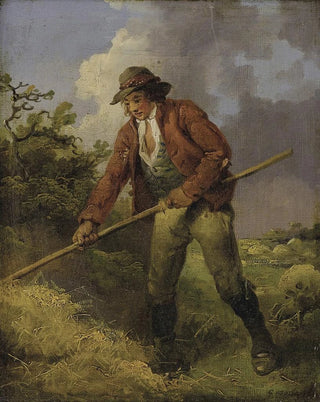Art print | Making hay - George Morland


View from behind

Frame (optional)
The "Faire du foin" canvas by George Morland is an iconic artwork that immerses us in a pastoral universe filled with serenity. This painting, created at the end of the 18th century, evokes the simple and authentic beauty of rural life. Morland, known for his ability to capture scenes of everyday life, invites us to appreciate the tranquility of a moment suspended in time, where characters are engaged in an essential task. Through this work, the artist manages to convey an atmosphere of peace and harmony, encouraging the viewer to lose themselves in the details of the surrounding nature. The soft light bathing the scene adds an almost magical dimension, making the contemplative experience even more profound.
Style and uniqueness of the work
Morland's style is distinguished by its realism and its ability to evoke emotions through careful compositions. In "Faire du foin", the artist uses warm, earthy colors that recall the richness of English landscapes. The characters, although depicted in their daily activity, are imbued with a certain nobility, reflecting Morland's respect for rural life. The details of clothing, tools, and natural elements are rendered with remarkable precision, demonstrating the artist's meticulous observation. The dynamic between human figures and their environment creates a harmonious balance, where each element seems to play a role in visual storytelling. The composition, though simple, is loaded with meaning, inviting the viewer to reflect on the relationship between man and nature.
The artist and his influence
George Morland, born in 1763, is a significant figure in British art, whose work has influenced many artists. His passion for peasant life and his commitment to representing the beauty of English landscapes made him a pioneer in the genre of rural landscape. Morland was able to capture the spirit of his time, during an era when the industrial revolution was beginning to transform the cultural and social landscape of England. His work, often tinged with melancholy, highlights the challenges faced by farmers and peasants, while celebrating their resilience. Scenes of everyday life that

Matte finish

View from behind

Frame (optional)
The "Faire du foin" canvas by George Morland is an iconic artwork that immerses us in a pastoral universe filled with serenity. This painting, created at the end of the 18th century, evokes the simple and authentic beauty of rural life. Morland, known for his ability to capture scenes of everyday life, invites us to appreciate the tranquility of a moment suspended in time, where characters are engaged in an essential task. Through this work, the artist manages to convey an atmosphere of peace and harmony, encouraging the viewer to lose themselves in the details of the surrounding nature. The soft light bathing the scene adds an almost magical dimension, making the contemplative experience even more profound.
Style and uniqueness of the work
Morland's style is distinguished by its realism and its ability to evoke emotions through careful compositions. In "Faire du foin", the artist uses warm, earthy colors that recall the richness of English landscapes. The characters, although depicted in their daily activity, are imbued with a certain nobility, reflecting Morland's respect for rural life. The details of clothing, tools, and natural elements are rendered with remarkable precision, demonstrating the artist's meticulous observation. The dynamic between human figures and their environment creates a harmonious balance, where each element seems to play a role in visual storytelling. The composition, though simple, is loaded with meaning, inviting the viewer to reflect on the relationship between man and nature.
The artist and his influence
George Morland, born in 1763, is a significant figure in British art, whose work has influenced many artists. His passion for peasant life and his commitment to representing the beauty of English landscapes made him a pioneer in the genre of rural landscape. Morland was able to capture the spirit of his time, during an era when the industrial revolution was beginning to transform the cultural and social landscape of England. His work, often tinged with melancholy, highlights the challenges faced by farmers and peasants, while celebrating their resilience. Scenes of everyday life that






